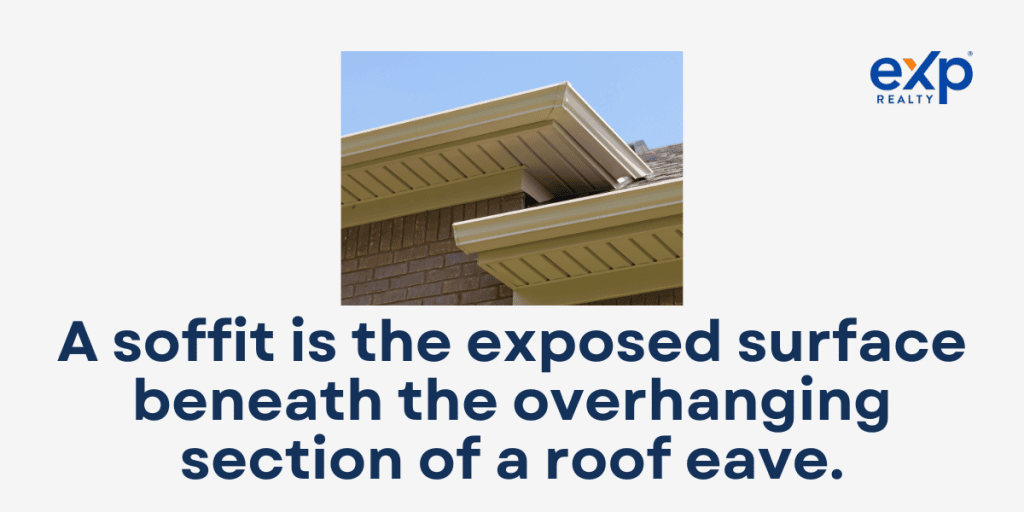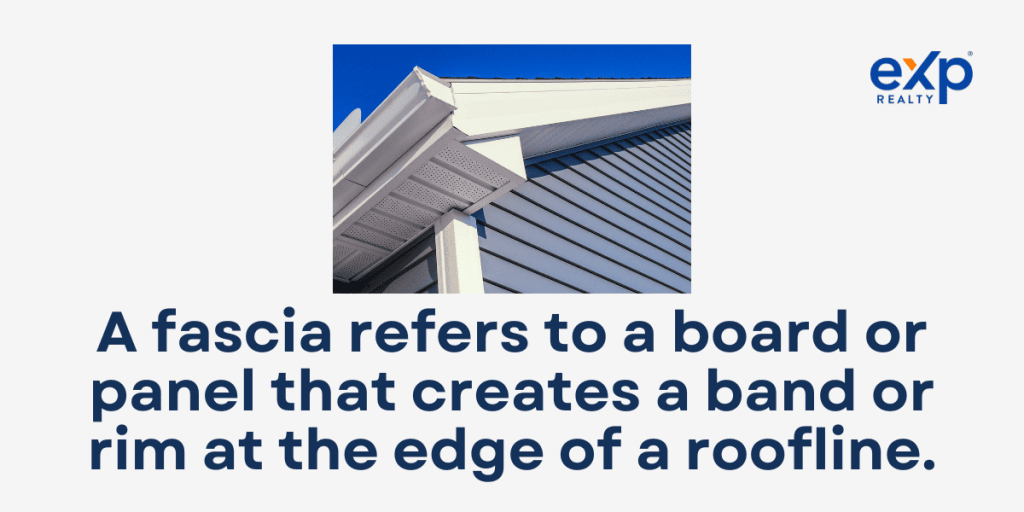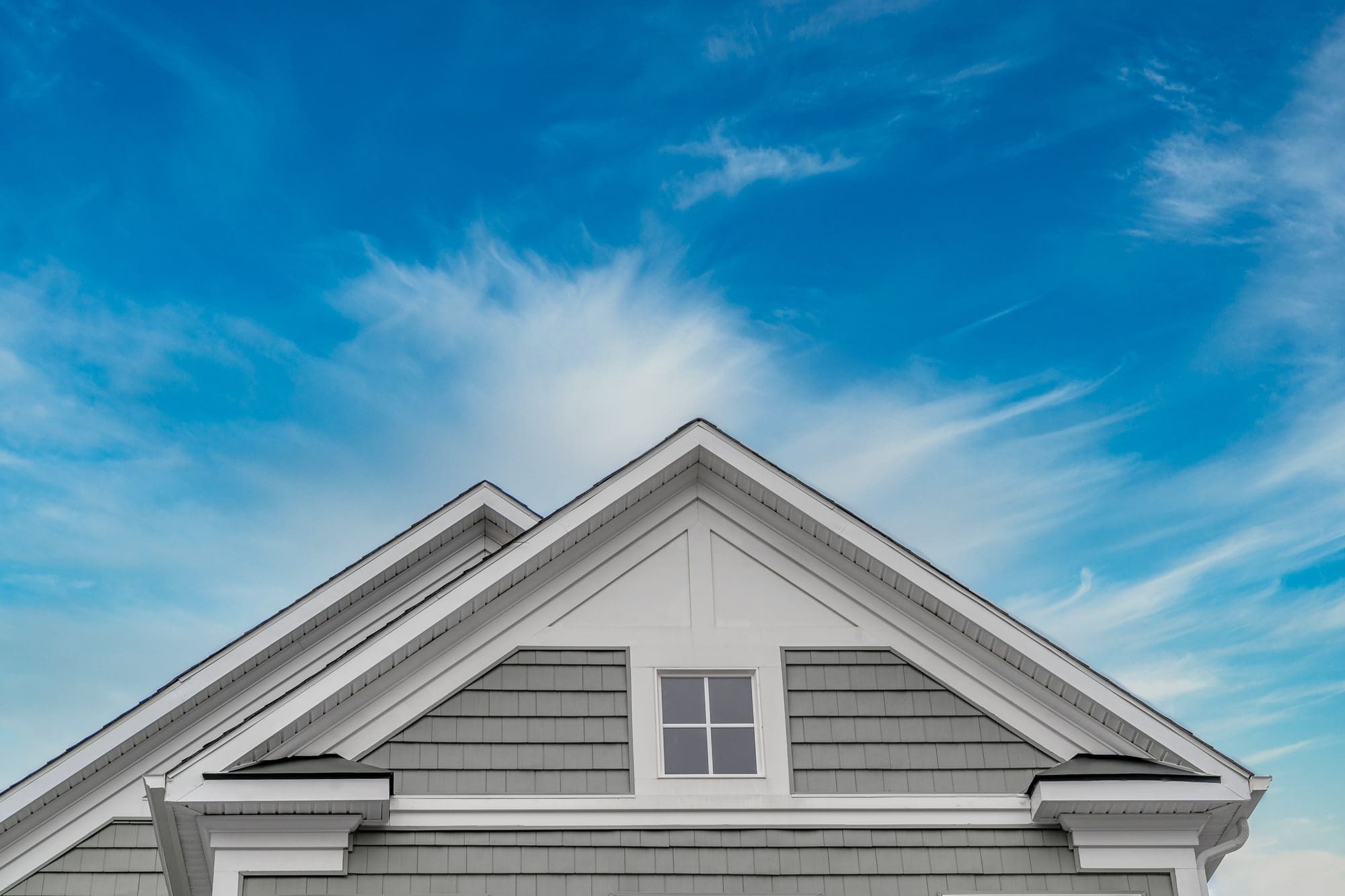Understanding the structural components of a building is essential in maintaining the longevity and aesthetic appeal of your property. Two such critical yet often overlooked components are the soffit and fascia.
A soffit is the exposed surface beneath the overhanging section of a roof eave. It helps to ventilate the attic and prevent moisture buildup that can cause mold and rot. Fascia is the vertical board that covers the end of the roof rafters. It supports the roof edge and provides a base for the gutters.
Both soffit and fascia protect the roof from weather damage and pests, as well as enhance the curb appeal of your property. If you’re looking to keep your home in top shape, it’s worth understanding what soffit and fascia are all about, and this eXp guide will help you do that.
What is a Soffit?

Soffit originates from the Latin term “suffixes,” which means “fixed underneath.” True to its name, a soffit is the exposed surface beneath the overhanging section of a roof eave. It is crucial in assisting air circulation in attic spaces, mitigating the likelihood of moisture buildup, and protecting the roof’s structural integrity.
Constructed from various materials, the choice for soffit boards is plentiful. From vinyl soffits, known for their durability and low maintenance, to aluminum soffits lauded for their heat resistance, and even wood soffits for their traditional appeal, a range of options suits various architectural styles and climates. For eco-friendly homeowners, fiber-cement soffit such as James Hardie is a popular choice due to its sustainable nature.
You can find soffit boards made of steel or fiber cement to broaden your options further. While less common, steel soffits offer superior durability and strength, making them an excellent choice for areas prone to severe weather.
Fiber cement soffits are highly versatile and robust, boasting high resistance to fire, rot, and insect damage. They’re also ideal for those seeking a particular aesthetic, as they can be painted in any color. Installing a well-designed and correctly placed soffit comes with a myriad of benefits:
- Improved Ventilation and Airflow: A significant function of the soffit is to facilitate proper ventilation within the attic spaces. It allows a continuous flow of air, which aids in dissipating heat during warmer climates and reducing energy costs.
- Enhanced Aesthetics and Curb Appeal: Soffits enhance the overall visual appearance of a building. They come in a variety of colors and materials, making matching the exterior decor easier and improving the building’s curb appeal.
- Protection Against Moisture and Weather Damage: Soffits protect the rafters from water damage from inclement weather. By offering this line of defense, soffits can prolong the life of the building’s roof structure.
Other benefits include preventing the entry of pests and providing a clean, finished look to the underside of the eaves. Furthermore, soffits may also accommodate light fixtures, providing outdoor illumination that can add to the building’s security.
Understanding the intricacies of soffit installations or replacements, including labor costs, material choice, and area measurements. For instance, the average installation cost varies with the chosen material and size of the area (measured in linear feet). A professional can provide a detailed assessment and quote, considering these variables.
Despite the initial investment, the preventative capabilities of soffits, such as shielding the roof and walls from water damage, can save homeowners expensive repair costs down the line. Therefore, the importance of a well-installed soffit system must be balanced.
Similarly, regular maintenance of soffits is crucial to extend their lifespan and keep them functioning optimally. This includes inspecting them for signs of damage or wear, clearing any blockages in the ventilation, and repainting them as needed to maintain their appearance and protect them from the elements.
What is a Fascia?

In the architectural realm, a fascia refers to a board or panel that creates a band or rim at the edge of a roofline. While often overlooked, fascias are pivotal in maintaining a building’s exterior by serving as a connective tissue that links the roof, soffits, and gutters.
The fascia board is mounted on the exposed ends of your rafters or to the top of the exterior walls. This creates a barrier between the edge of your roof and the outside elements.
The Fascia Materials
The choice of fascia materials can vary significantly, often influenced by factors such as climate, the architectural style of the building, and personal preference.
Common materials include aluminum fascia boards known for their longevity and resistance to rust, wood fascias with a traditional and rustic appeal, and composite soffits lauded for their resilience to rot. In addition, synthetic materials such as vinyl or unplasticized polyvinyl chloride (uPVC) are often chosen for their low-maintenance properties.
The Benefits of Fascia
Fascias provide an additional layer of thermal insulation, helping to keep your home warm during the colder months and cool during the summer. This can contribute to lower energy bills and more comfortable living conditions.
By providing a seal between your roof and the exterior, fascias also help to reduce noise pollution, creating a quieter and more peaceful environment inside your home.
A well-installed fascia offers numerous functions and benefits:
- Support for the Gutter System: Fascia boards provide robust and secure support for the gutter system, particularly during heavy rains when the gutters are laden with water and debris. Ensuring a strong fascia can thus significantly improve the lifespan of your gutters.
- Protection Against Water Intrusion and Damage: As a barrier between the edges of the roof and the elements, fascias protect the building’s interior from water intrusion, thus preventing potential damage to the roof and the interior walls.
- Enhancing the Overall Appearance of the Roofline: Fascia boards can be painted in various colors to match the exterior decor of the building, thereby enhancing its overall aesthetic appeal. A well-maintained fascia can dramatically improve the building’s curb appeal and value.
Aside from the benefits above, fascia boards also help prevent the entrance of animals and pests into the roof and attic spaces. They form a vital part of the overall roofing system and, like soffits, contribute significantly to the structural integrity of a building.
Fascia Installation & Maintenance

Like soffit installations, fascia installation or replacement requires careful planning and understanding of the costs involved. Factors such as material choice, labor costs, and the linear feet of the fascia required will influence the total cost. However, considering the vital role of fascia in the durability and aesthetic appeal of a building’s exterior, it is an investment worth making.
Keep in mind maintenance for your fascia is equally crucial as its installation. Over time, exposure to the elements can lead to wear and tear. Regularly inspecting your fascia for signs of damage, such as cracks or peeling paint, is vital. Quick repairs or replacements can prevent minor issues from escalating into major problems that could affect the overall health of your roof.
Remember that the complexity and hard-to-reach areas of fascia installation often necessitate the expertise of a professional. They can ensure proper installation that conforms to the building codes and standards, guaranteeing the fascia’s longevity and effectiveness.
The Importance of Soffit and Fascia in Roof Health
While often overlooked in the broader scope of roof health, the soffit and fascia play integral roles in your roof’s overall well-being and lifespan. These critical elements not only enhance the aesthetics of your home but also ensure proper ventilation, moisture control, and structural support for the roof system.
The soffit is vital to the roof’s ventilation system, promoting consistent airflow between the roof and the attic. This proper ventilation is key to moderating temperature extremes and reducing energy costs. Moreover, it helps prevent condensation buildup, thus mitigating the risk of water damage, mold growth, and rotting rafters.
On the other hand, the fascia provides crucial support for your roof’s gutter system, preventing water intrusion during adverse weather conditions. By effectively directing rainwater away from your roof and home’s foundation, it minimizes the potential for serious water damage.
Neglecting the maintenance of your soffit and fascia can lead to a plethora of roofing issues, some of which may require extensive repairs:
- Ice Dams and Water Damage: In colder climates, inadequate ventilation can lead to the formation of ice dams. These occur when heat from your attic melts snow on your roof, causing it to refreeze on the cooler eaves and form ice dams. Over time, these dams can force water to back up underneath the shingles, causing extensive water damage.
- Pest Infestations and Wood Decay: Damaged or poorly maintained soffits can become entry points for pests such as squirrels, bats, and birds, which can cause substantial damage to your attic and roof structure. Moreover, rotting fascia boards can compromise the integrity of your gutter system and cause water to seep into the walls, leading to structural damage.
- Increased Energy Costs: Poorly ventilated attic spaces can become extremely hot during the summer, forcing your air conditioning system to work harder and raising energy costs. A properly functioning soffit ensures efficient air circulation, helping maintain a cooler attic and reducing energy consumption.
- Deterioration of Buildings Aesthetic: If not properly maintained, soffits and fascia can begin to deteriorate over time, affecting your home’s overall look and appeal. Peeling paint, stains from water damage, and visible rot are all unsightly issues that can be avoided with regular maintenance.
- Compromised Structural Integrity: Water penetrating the soffit or fascia can seep into your home’s structure, potentially leading to widespread damage and costly repairs. This can affect the stability of your home’s foundation, leading to significant safety risks.
Other issues from neglected soffit and fascia maintenance include a diminished curb appeal due to peeling paint or rotting wood and potential safety hazards from loose or falling roof or gutter system sections. Regular maintenance and timely soffit and fascia repairs are paramount to ensure a healthy roof and a safe, comfortable home.
Key Takeaways
Understanding the integral roles that soffit and fascia play in your home’s health and aesthetic appeal is crucial for every homeowner. Though often overlooked, these components serve as the home’s vital connective tissues, keeping your roof structure secure, promoting proper ventilation, and enhancing your home’s curb appeal.
Soffits, typically installed on the underside of your roof’s overhangs, protect your rafters from weather damage and ensure consistent air circulation within your attic spaces. This airflow regulation helps maintain comfortable temperatures in your home and prevents potential energy inefficiencies, resulting in lower energy costs.
Conversely, fascia acts as the outer edge of your roof, providing much-needed support for your gutter system. These structural elements safeguard your home from water damage by guiding rainwater away from your roof and home’s foundation.
Choosing high-quality soffit and fascia materials, whether aluminum soffit and fascia boards or more expensive materials like fiber cement from brands like James Hardie, can significantly impact the longevity and durability of your roof and home. These components come in various colors and material options, allowing you to select a style that aligns with your home’s aesthetic and budget.
When choosing soffit and fascia materials, it’s important to consider your area’s climate and weather conditions. For instance, aluminum may be the best choice in coastal regions due to its resistance to saltwater corrosion, while wood may be more suitable for drier climates. Energy efficiency should also be a factor in your decision, as some materials provide better insulation. Consult with a professional to make the most informed choice.
Remember, neglecting these elements can lead to serious problems, from water damage and pest infestations to increased energy costs. Therefore, proactive maintenance and timely fascia replacement or repairs are paramount to keeping your roof healthy and ensuring your home’s long-term structural integrity.
If you’re planning a siding project or considering investing in a fascia installation or replacement, don’t hesitate to contact a professional to ensure the job is done correctly. At eXp Realty, we can connect you with experienced local agents who can advise and recommend trusted contractors. Contact a local eXp agent today to start your journey towards a safer, more energy-efficient home.
In addition to advising contractors, our agents can provide valuable insights into the potential return on investment you can expect from installing high-quality soffits and fascia. These elements can greatly enhance the curb appeal of your home, which can significantly increase its market value if you ever decide to sell.
Our agents can help you understand the value-add from these home improvements and guide you towards making the most cost-effective decisions. You can also do a custom home search and sign up for alerts for new property listings when they come on the market.
Frequently Asked Questions: Soffit And Fascia
In your journey to better understand the importance of soffits and fascia for your home, you might encounter a variety of questions. Here, we answer some of the most common queries regarding these essential architectural elements.
What is fascia and soffit?
Fascia and soffit are vital parts of a building’s exterior that protect the roof and the interior from weather damage. The fascia is a horizontal board installed along the edge of a roofline to support the gutter system. In contrast, the soffit, installed on the underside of roof overhangs, provides ventilation and protection against moisture damage.
What are two common problems with soffits and fascia?
Common problems with soffits and fascia include:
- Water damage.
- Leading to rot and decay.
- Inadequate ventilation leads to increased energy costs.
Pest infestations are also common due to the soffit and fascia’s hard-to-reach areas.
How hard is it to replace the soffit?
Replacing the soffit can be challenging, especially for those with prior experience. It involves removing the old soffit, inspecting and repairing any underlying damage, and installing the new soffit – a process that requires proper tools and skills.
Is fascia part of the roof or siding?
Fascia is considered part of the roof system as it supports the gutter system and seals off the roof’s outer edge. However, it also plays a significant role in the overall aesthetic of the home’s siding.
What is the life expectancy of a fascia and soffit?
The life expectancy of fascia and soffit largely depends on the material used and the quality of installation and maintenance. Generally, well-maintained aluminum or vinyl soffit and fascia can last 20-30 years.
Can you replace the fascia without replacing the soffit?
Yes, it is possible to replace the fascia without replacing the soffit if it is in good condition. However, if both are damaged, it is advisable to replace them simultaneously to ensure your roof system’s overall health.
Does Home Depot install fascia and soffit?
Many home improvement stores, like Home Depot, offer professional installation services for fascia and soffit, although availability may vary based on location.
What is the labor cost to install the soffit?
The labor cost to install soffit varies depending on the project’s complexity, the type of material used, and the contractor’s rates. On average, homeowners can expect to pay between $20 and $30 per linear foot for professional soffit installation.
How do you fix rotted fascia and soffit?
Fixing rotted fascia and soffit involves:
- Identifying the extent of the damage.
- Removing the decayed sections.
- Replacing them with new material.
Given the potential complexity and the need for proper installation, hiring a professional for this task is often best.





